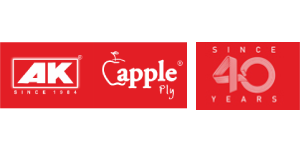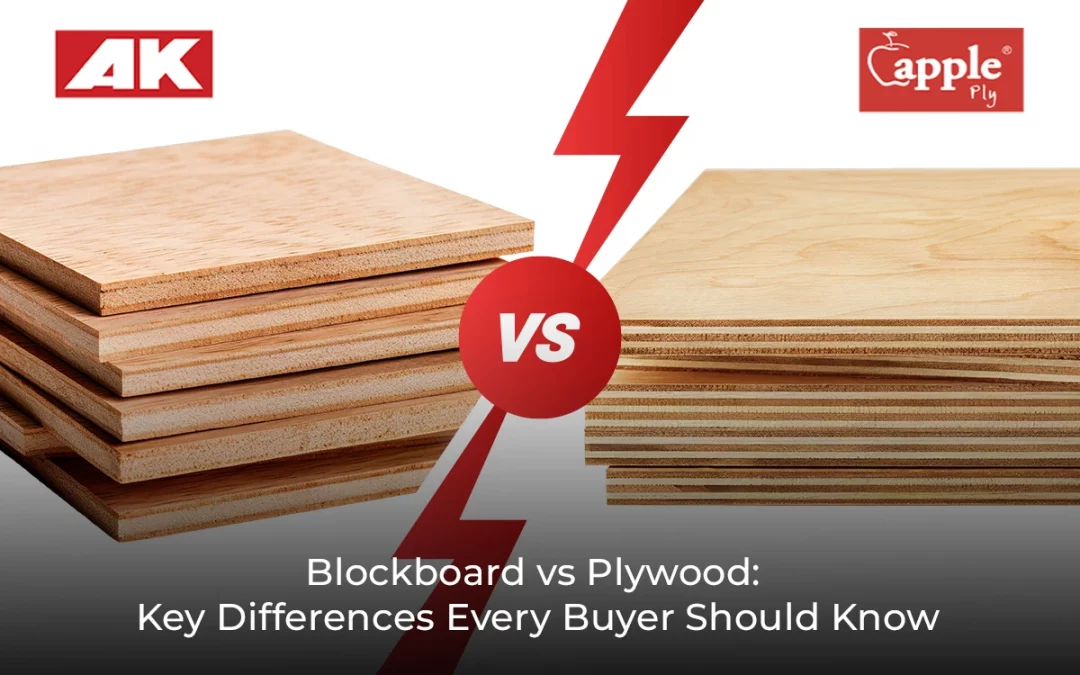Choosing the right wood materials is essential when creating beautiful furniture for your home, like fancy wooden cabinets, sleek modular kitchens, sofas, or beds. Especially when there are so many options available, Blockboard and Plywood are the two most popular wood options, and people tend to get confused about them.
Because they both look similar at first glance but have plenty of differences that people must know, each one is used for different purposes and is required for other projects.
In this blog, we will explain everything about plywood and blockboard, their applications, and the key differences between them so that you can determine which one is suitable for your furniture needs.
What is Plywood?
Plywood is a highly durable wood material made by bonding thin layers of wood (called plies) with glue. The grains of each layer (2-4 mm thick) were rotated by 90° and then glued together under high pressure to create a strong panel. Plywood is flexible and resistant to warping, making it ideal for various uses. From indoors to outdoors, plywood is used for a wide range of projects, including flooring, furniture, and even roof sheathing. Plywood manufacturer grade based on its appearance, with ratings from A to D. The grade shows how smooth and flawless the surface is, where A stands for flawless high-quality plywood, and D stands for low-quality and lousy plywood appearance. When comparing block board and plywood, plywood stands out for its versatility and ease of use.
Applications of Plywood
Here are some key applications where plywood is used:
- Furniture: It’s perfect for furniture with curves or rounded edges. Because it’s easy to bend and shape plywood without cracking.
- Flooring: It provides stability and strength, making it ideal for subflooring and finished floors.
- Outdoor Furniture: Plywood is water-resistant and great for outdoor uses, such as garden furniture.
- Wall Paneling & Cabinets: Plywood is strong, lightweight, and resists warping, making it great for storage units.
- Partitions & Ceilings: Plywood is perfect for indoor partitions and ceilings because it’s lightweight and durable.
What is a Blockboard?
Blockboard is a type of wood made by placing solid wood strips in the center, with thin veneer panels on both sides. The wood strips are glued and pressed under heat to create a strong sheet. It is usually about 3/8-inch to 13/16-inch thick and designed for indoor and outdoor furniture like doors, shelves, and partitions because it’s stable and lightweight.
Applications of Blockboard
Here are some key applications of blockboard:
- Interior Doors: Blockboard is lightweight and sturdy, which makes it ideal for easy-to-handle interior doors.
- Wall Panels in Dry Interiors: It’s also used for smooth wall panels in dry spaces like living rooms.
- Furniture with Long Horizontal Surfaces: It’s used for desks, tables, and benches, preventing sagging.
- Partitions in Dry Areas: It is used for room dividers in dry areas with good sound insulation.
- Extended Bookshelves and Tables: It is also used for extended shelves and tables that need extra strength.
Related Blog: From Boring to Beautiful: How HDHMR Boards Can Add Character to Your Home
Plywood Vs Blockboard: Key Differences Between Them
Here are the key differences between plywood and blockboard:
| Plywood | Blockboard | |
| Material | Plywood is made by gluing thin layers of wood (called veneers) together in a criss-cross pattern | Block Board comprises softwood strips glued together and covered with wood fenders on both sides |
| Manufacturing Process | Thin layers of wood are glued in alternating directions and pressed under heat for extra strength | Softwood strips are glued together, covered with veneers, and pressed under heat and pressure |
| Uses | It’s Great for furniture, cabinets, wall panels, flooring, and even structural work like roofing | It’s also perfect for doors, long shelves, tables, and partitions where you need something lightweight |
| Features | Strong, flexible, and available in moisture-resistant and fire-retardant grades | Lightweight, stiff, and great for sound and thermal insulation |
| Properties | Doesn’t warp or crack easily and is suitable for bending and curved designs | It doesn’t bend easily but can absorb moisture if not treated |
| Sizes | It’s available in a wide range of sizes, catering to the needs of various constructions | It’s available in standard sizes and can be customized based on the project’s requirements |
| Strength & Durability | It is ideal for heavy-duty use and structural projects | It’s moderately strong and suitable for lightweight furniture but less durable for heavy loads |
| Ease of Handling | It is heavier and harder to transport due to dense composition. | Lighter and easier to handle, making it convenient for construction projects. |
| Screw holding capacity | Holds screws tightly and is excellent for fastening | Good screw-holding capacity, but screws may loosen if placed in gaps within the core |
| Sound Insulation | Blocks sound well due to their dense structure | The softwood core provides good sound and heat insulation |
| Grades | Available in MR (Moisture Resistant), BWR (Water Resistant), BWP (Marine Grade), and FR (Fireproof). | Available in MR, BWR, and BWP grades. |
| Water and moisture resistant | Highly resistant with grades like BWR and Marine Ply and good for bathrooms and kitchens. | Less moisture-resistant; needs sealing for use in humid areas. |
| Cost | It’s expensive, especially in higher grades. | It’s cheaper and more budget-friendly for basic applications. |
| Weight | Heavy due to its dense veneer layers. | Lightweight because of the softwood core. |
| Maintenance and Life | It is long-lasting and low maintenance and can last up to 50 years if properly cared for. | It’s durable with regular maintenance but may not last as long in moist conditions. |
Also Read: Where to Buy the Best Plywood in Kochi: Top 5 Trusted Plywood Brands
Conclusion
Overall, plywood and blockboard are both essential materials, but they have different uses and purposes in furniture, whereas blockboards are suitable for projects that need long, strong panels. Meanwhile, plywood is a more substantial choice for furniture and construction projects. To choose between plywood and blockboard, you need to understand your project needs and determine which one suits your project. But make sure to choose only high-quality materials for the long-term Durability of your project.
Looking for high-quality plywood or blockboard for your project? Visit the AK Plywood, a trusted plywood brands website and explore our high-quality and wide range of collections at an affordable price. Connect with our experts today!
Frequently Asked Questions (FAQs)
1. What is the difference between plywood and blockboard?
Plywood is made of thin wood layers glued together, which makes it strong and flexible. On the other hand, block boards have solid wood strips inside and are lighter, making them great for indoor furniture.
2. Is plywood waterproof?
Some plywoods come with water-resistant properties, such as BWR or Marine Ply.
3. Can the blockboard be used outdoors?
Blockboard is not suitable for outdoors as it absorbs moisture and can warp.
4. Which one is easier to handle?
Block Board is easier to handle because it’s lighter than plywood.
5. How do I choose between plywood and blockboard for my project?
Choose plywood for strength and moisture resistance. And choose a blockboard for lightweight indoor furniture.
Dr. Prasanth M.A. is the Director of AK Applye Plywood, a trusted name in the plywood and interior solutions industry. With over a decade of expertise in wood technology and sustainable manufacturing, he is passionate about delivering high-quality, innovative plywood products that meet both functional and aesthetic needs. Dr. Prasanth is committed to promoting eco-friendly materials and has been a key figure in driving industry best practices in durability, design, and customer-centric solutions. Under his leadership, AK Applye Plywood has grown into a brand synonymous with quality craftsmanship and reliability in the Indian plywood market.




